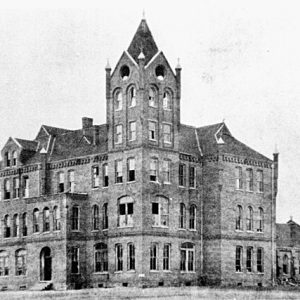calsfoundation@cals.org
Quitman Male and Female College
Quitman Male and Female College was a Methodist institution of higher education that operated in Quitman (Cleburne County) from 1870 until 1898. Over its years of operation, an estimated 3,000 men and women attended the college.
Quitman Male and Female College can trace its origins to Quitman Male and Female Institute (sometimes referred to as Quitman Institute), founded in 1869. Professor G. W. Stewart was the administrator of Quitman Institute, which could accommodate 200 students. It is believed that Stewart made a gift of the Quitman Institute to the Methodist Church; afterward, the school became Quitman Male and Female College. The college’s first president, the Reverend Peter A. Moses, came to lead the institution in 1871 and would go on to lead the institution for three years, to be followed by an eventual nine successors, most of whom were Methodist clergy.
Quitman Male and Female College was considered a “mountain school” (based on its geographic location) and advertised its location as lacking in vice and other distractions that might hinder young people’s development and educational pursuits, especially because Quitman was far away from a railroad. Quitman College was the property of the Methodist Church, South and under the auspices of the Arkansas Annual Conference. The sons and daughters of Methodist ministers could attend free of charge. The college relied on donations from the church, donations from the community, and tuition and fees collected from students for its operational expenses. The college began in a two-story wood-frame building, eventually adding a home for the president and a second two-story frame building with a chapel.
In 1887, the Arkansas Annual Conference sought to close Quitman Male and Female College and give the property and charter to the local school district to open a high school. The Quitman community rallied around the college; soon after, the college enlarged its faculty and built a three-story brick building on a new, fifteen-acre campus (the original campus became facilities for the remedial, preparatory school), while the trustees created a $50,000 endowment. The college curriculum offered such courses as Latin, Greek, French, German, science and mathematics, humanities, and biblical literature and awarded the degrees of bachelor of philosophy, bachelor of arts, master of arts, or mistress of English literature. Students had to adhere to a strict code of conduct, including daily prayers; chapel and Sunday school attendance; abstinence from tobacco, alcohol, and disorderly conduct; and mandatory study hours within the confines of their rooms.
Despite the growth and advances at Quitman Male and Female College, the Arkansas Conference never adequately appropriated monies to support the institution financially. As a result of a financial recession in the 1890s, the college was forced to close in 1898. The college’s three-story brick building later became the Quitman Public School and was used by the public school district until it was destroyed by fire in 1932.
For additional information:
Alderson, Willis Brewer. “A History of Methodist Higher Education in Arkansas1836–1933.” EdD diss., University of Arkansas, 1971.
Jewell, Horace. History of Methodism in Arkansas. Little Rock, AR: Press Printing Company, 1892.
“Quitman and the College.” Cleburne County Historical Journal 5 (Winter 1979): 124–135.
Reynolds, John High, ed. Publications of the Arkansas Historical Association. Vol. I. Fayetteville: Arkansas Historical Association, 1906.
Rolf, Carol. “Ole Main Served Quitman School District for Years.” Arkansas Demcorat-Gazette. River Valley and Ozark Edition. July 23, 2009. http://www.arkansasonline.com/news/2009/jul/23/ole-main-served-quitman-school-district-y-20090723/ (accessed February 9, 2022).
Shinn, Josiah H. History of Education in Arkansas. United States Bureau of Education Circular of Information No.1, 1900. Washington DC: Government Printing Office, 1900.
Nicola Davis Bivens
Johnson C. Smith University
 Quitman Male and Female College
Quitman Male and Female College 




I have just learned that my grandmother attended Quitman College. I only know she was born in 1872. She was very musically inclined. Her name was Ruth Straumit Garner. She later married my grandfather, Dr. George Huddleston. They are buried in Lamar at a Methodist Church cemetery. Several other relatives were also educated at Quitman: Robert Chauncey Garner and Willie Anne Garner. There was some relationship with the Cazort Brothers Mercantile.